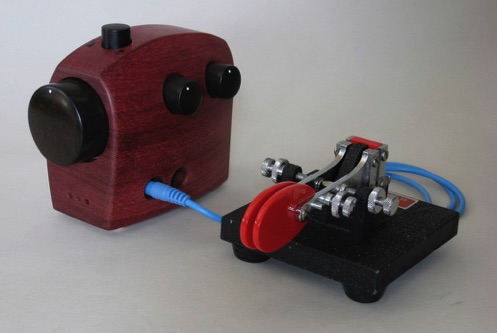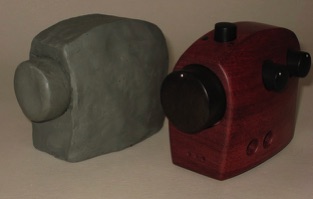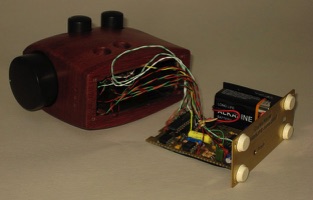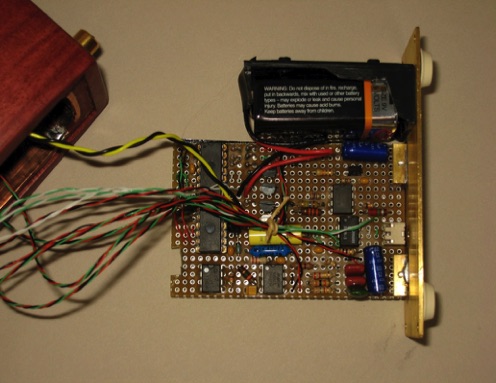Electronic Keyer in a Sculpted Wood Enclosure
Here’s an unusual packaging job for an otherwise conventional keyer. It’s based on a Curtis 8045ABM single-chip keyer and is battery-powered. The enclosure is purpleheart, a fine African wood with a unique purple color (sadly, it’s a fugitive color, fading over time to a medium brown). Knobs are Ebony. This is one of those projects where I got to throw all of my hobby-related skills into the mix.

Design started with some sketches, then I made a full-sized clay mockup including knobs. Some guesswork is required to allocate enough interior volume for the circuit board, battery, and wiring. It’s packed extremely tight. Fabrication of the main body started on my vertical mill to make the large cavity. That was the only way I could handle the very long 1/2” cutter needed for the extreme depth. One disturbing thing happened along the way: Hardwoods with thick dimensions often have internal stress from uneven drying, and this piece was no exception. Upon wasting all that material from the cavity, stress was redistributed, additional moisture evaporated, and the resulting uneven shrinkage caused checks (cracks) all through the piece. The good news is that the cracks tend to self-heal as the moisture and stress equilibrates over several days. In the end, it looked just fine.


Holes and recesses for the controls were tricky to make because of the curved geometry. The trick is to take accurate measurements from the clay mockup, and do most of the drilling before the exterior curves are cut on the bandsaw. That give you a fighting chance of keeping all the angles and depths in registration. Finish is Watco oil and wax.
Knobs were turned on the lathe and carefully polished. Their functions are: speed (the big one), weighting, speaker volume, and a button on top for the memory functions. There are a couple of LEDs on top (barely visible) for memory feedback and a low battery indicator. Input jacks are for the paddle and a hand key. Another jack in the rear is the keyed output.
The Circuit
I like the Curtis chip because of its analog controls. The first page of the schematic is devoted to that chip, and an associated EEPROM to expand the memory and make it nonvolatile.
The second page is the interesting part. I wanted auto-on and auto-off to preserve battery life while avoiding the need for a manual switch. I used a PMOSFET as the power switch, biased ON when any of the keying inputs goes low. The very low gate leakage allows a modest capacitor to keep it activated for many minutes. A diode OR gate charges the timing capacitor from the keying inputs. For low leakage diodes, the base-collector junction of a BJT works really well. To keep the keyer chip happy with varying battery voltage, I used a MAX666 low-dropout regulator. It also gives you a low-battery indicator.
On the third page is the sidetone amplifier which drives a tiny built-in speaker. I used a trusty LM386, which has reasonably low quiescent current. Another bizarre trick I implemented is an electronic power switch for the amplifier. Why? Because I could not find small pot with a switch. The trick here is to apply a DC bias to the volume pot, measure that with a comparator (U3), and turn on the 9V power to the amplifier only when the volume pot is turned up a bit off of zero.
